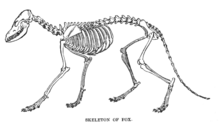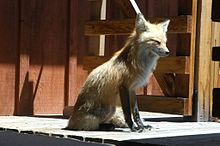Fox
This article needs additional citations for verification. (May 2007) |
| Foxes | |
|---|---|

| |
| Red Fox (Vulpes vulpes) | |
| Scientific classification | |
| Kingdom: | |
| Phylum: | |
| Class: | |
| Order: | |
| Family: | |
| Genera | |
Fox is a common name for many species of alert omnivorous mammals belonging to the Canidae family. Foxes are small-to-medium-sized canids (slightly smaller than a medium-sized domestic dog), with a flattened skull, upright triangular ears, a pointed, slightly upturned snout, and a long bushy tail (or brush).
Members of about 37 species are referred to as foxes, of which only 12 species actually belong to the Vulpes genus of "true foxes". By far the most common and widespread species of fox is the red fox (Vulpes vulpes), although various species are found on almost every continent. The presence of fox-like carnivores all over the globe, together with their widespread reputation for cunning, has contributed to their appearance in popular culture and folklore in many societies around the world (see also Foxes in culture). The hunting of foxes with packs of hounds, long an established pursuit in Europe, especially the British Isles, was exported by European settlers to various parts of the New World.
Etymology
The word fox was inherited from Old English, itself from Proto-Germanic *fuhsaz; compare West Frisian foks, Dutch vos, and German Fuchs. This in turn derives from Proto-Indo-European *puḱ- ‘thick-haired; tail’, which also gave Hindi pū̃ch ‘tail’, Tocharian B päkā ‘tail; chowrie’, and Lithuanian paustìs ‘fur’. The bushy tail also forms the basis for the fox's Welsh name, llwynog, literally ‘bushy’, from llwyn ‘bush’.[1] Likewise, Portuguese: raposa from rabo ‘tail’,[2] Lithuanian uodẽgis from uodegà ‘tail’, and Ojibwa waagosh from waa, which refers to the up and down "bounce" or flickering of an animal or its tail.[3] Male foxes are known as dogs, tods or reynards, females as vixens, and young as cubs pups or kits. A group of foxes is referred to as a skulk, leash, troop, or earth.
General characteristics

In the wild, foxes can live for up to 10 years, but most foxes only live for 2 to 3 years due to hunting, road accidents and diseases. Foxes are generally smaller than other members of the family Canidae such as wolves, jackals, and domestic dogs. Male foxes are called Reynards, and weigh, on average, around 5.9 kilograms (13 lb) while female foxes, called vixens, weigh less, at around 5.2 kilograms (11.5 lb).[4] Fox-like features typically include a distinctive muzzle (a "fox face") and bushy tail. Other physical characteristics vary according to habitat. For example, the fennec fox (and other species of fox adapted to life in the desert, such as the kit fox) has large ears and short fur, whereas the Arctic fox has tiny ears and thick, insulating fur. Another example is the red fox which has a typical auburn pelt, the tail normally ending with white marking. Litter sizes can vary greatly according to species and environment – the Arctic fox, for example, has an average litter of four to five, with eleven as maximum.[5]
Unlike many canids, foxes are not always pack animals. Typically, they live in small family groups, and are opportunistic feeders that hunt live prey (especially rodents). Using a pouncing technique practiced from an early age, they are usually able to kill their prey quickly. Foxes also gather a wide variety of other foods ranging from grasshoppers to fruit and berries. The gray fox is one of only two canine species known to climb trees; the other is the raccoon dog.
Foxes are normally extremely wary of humans and are not usually kept as indoor pets; however, the silver fox was successfully domesticated in Russia after a 45-year selective breeding program. This selective breeding also resulted in physical and behavioral traits appearing that are frequently seen in domestic cats, dogs, and other animals, such as pigmentation changes, floppy ears, and curly tails.[6]
Classification
Canids commonly known as foxes include members of the following genera:
- Alopex: Arctic fox, although the definitive mammal taxonomy list as well as genetic evidence places it in Vulpes, and not as a genus unto itself.
- Canis: The Ethiopian Wolf, also called, variously, Semien fox or Semien jackal (though recently renamed to reflect its biological affinity with the gray wolf).
- Cerdocyon: Crab-eating fox.
- Dusicyon: Falkland Islands fox.
- Lycalopex: Six South American species.
- Otocyon: Bat-eared fox.
- Urocyon: Gray fox, island fox and Cozumel fox.
- Vulpes: Including 12 species of true foxes, including the red fox, V. vulpes, Tibetan Sand Fox, Vulpes ferrilata and their closest kin.
-
The fennec fox is the smallest species of fox.
-
Arctic fox curled up in snow.
-
A Chilla fox in Pan de Azúcar National Park in the coast of Atacama Desert.
-
Crab-eating fox, a South American species.
Diet
Foxes are omnivores.[7][8] The diet of foxes is largely made up of invertebrates and small mammals, reptiles (such as snakes), amphibians, scorpions, grasses, berries, fruit, fish, birds, eggs, dung beetles, insects and all other kinds of small animals. Many species are generalist predators, but some (such as the crab-eating fox) are more specialist. Most species of fox generally consume around 1 kg of food every day. Foxes cache excess food, burying it for later consumption, usually under leaves, snow, or soil.
Conservation

Foxes are readily found in cities and cultivated areas and (depending upon species) seem to adapt reasonably well to human presence.
Red foxes have been introduced into Australia which lacks similar carnivores other than the dingo, and the introduced foxes prey on native wildlife, some to the point of extinction.
Other fox species do not reproduce as readily as the red fox, and are endangered in their native environments. Key among these are the crab-eating fox (Cerdocyon thous) and the African bat-eared fox. Other foxes such as fennec foxes are not endangered.
Foxes have been successfully employed to control pests on fruit farms while leaving the fruit intact.[9]
Relationships with humans

Fox attacks on humans are not common but have been reported. In November 2008, an incident in the United States was reported in which a jogger was attacked and bitten on the foot and arm by a rabid fox in Arizona.[10] In July 2002, a 14-week-old baby was attacked in a house in Dartford, Kent, United Kingdom.[11] In June 2010, 9-month-old twin girls were bitten on the arms and face when a fox entered their upstairs room in east London.[12]
Fox hunting
Fox hunting is an activity that originated in the United Kingdom in the 16th century. Hunting with dogs is now banned in the United Kingdom,[13][14][15][16] though hunting without dogs is still permitted. It is practiced as recreation in several other countries including Australia, Canada, France, Ireland, Italy, Russia and the United States.
Domestication
There are many records of domesticated red foxes and others, but rarely of sustained domestication. A recent and notable case is the Russian silver fox, or domesticated silver fox, since it resulted in visible and behavioral changes, and is a case study of an animal population modeling according to human domestication needs. The current group of domesticated silver foxes are the result of nearly fifty years of experiments in the Soviet Union and Russia to domesticate the silver morph of the red fox. Notably, the new foxes became more tame, allowing themselves to be petted, whimpering to get attention and sniffing and licking their caretakers.[17] They also became more dog-like as well: they lost their distinctive musky "fox smell", became more friendly with humans, put their ears down (like dogs), wagged their tails when happy and began to vocalize and bark like domesticated dogs. They also began to exhibit other traits seen in some dog breeds, such as color pattern, curled tails, floppy ears, and shorter legs and tails.[17] They are also more likely to have piebald coats, and will almost always have a white spot on the chest or face. The breeding project was set up by the Soviet scientist Dmitri K. Belyaev.
In culture
In many cultures, the fox appears in folklore as a symbol of cunning and trickery, or as a familiar animal possessed of magic powers.
In some countries, foxes are major predators of rabbits and hens. Population oscillations of these two species were the first nonlinear oscillation studied, and led to the now-famous Lotka-Volterra equation.
References
- ^ Jones, D.M. (1953). "Etymological Notes". Transactions of the Philological Society. 52: 43–51. doi:10.1111/j.1467-968X.1953.tb00269.x.
- ^ "Fox". The Online Etymology Dictionary. Retrieved 2009-04-03.
- ^ "Introduction to Ojibwe Language". Real-dream-catchers.com. Retrieved 2011-05-15.
- ^ Walker, Matt; Davies, Ella (7 March 2012). "Are red foxes getting bigger?" BBC News Online. Retrieved 2012-03-07.
- ^ Hildebrand, Milton (1952). "The Integument in Canidae". Journal of Mammalogy. 33 (4): 419–428. doi:10.2307/1376014. JSTOR 1376014.
- ^ Trut, Lyudmila N. (1999). "Early Canid Domestication: The Fox Farm Experiment" (PDF). American Scientist. 87.
- ^ Fedriani, J.M. (2000-07-05). "Competition and intraguild predation among three sympatric carnivores" (PDF). Oecologia. 125 (2): 258–270. doi:10.1007/s004420000448.
{{cite journal}}: Unknown parameter|coauthors=ignored (|author=suggested) (help) - ^ Fox, David L. (2007). "Vulpes vulpes (red fox)". Animal Diversity Web. University of Michigan Museum of Zoology.
- ^ McCandless, Linda Foxes are Beneficial on Fruit Farms. nysaes.cornell.edu (1997-04-24)
- ^ "Attacked jogger takes fox for run". BBC News. 2008-11-06.
- ^ "Baby 'attacked by fox'". BBC News. 2002-07-01.
- ^ "Twin girls injured in suspected fox attack". BBC News. 2010-06-06.
- ^ "Hunt campaigners lose legal bid". BBC News Online. 2006-06-23.
- ^ Singh, Anita (2009-09-18). "David Cameron 'to vote against fox hunting ban'". The Daily Telegraph. London. Retrieved 2010-05-02.
- ^ Fox Hunting. North West League Against Cruel Sports Support Group. nwlacs.co.uk
- ^ "Fox Hunting: For and Against" (PDF).
- ^ a b Kenneth Mason, Jonathan Losos, Susan Singer, Peter Raven, George Johnson(2011)Biology Ninth Edition, p. 423. McGraw-Hill, New York.ISBN 978-0-07-353222-6.
External links
- BBC Wales Nature: Fox videos
- BBC Wild About Nature: Fox facts and videos
- The fox website
- More fox sound files
- Australian Department of the Environment and Heritage fact sheet, 2004
- Fox in South London Video
 Texts on Wikisource:
Texts on Wikisource:
- Ripley, George; Dana, Charles A., eds. (1879). The American Cyclopædia.
{{cite encyclopedia}}: Missing or empty|title=(help) - Baynes, T. S., ed. (1879). Encyclopædia Britannica. Vol. 9 (9th ed.). New York: Charles Scribner's Sons.
{{cite encyclopedia}}: Missing or empty|title=(help) - "The Badger and the Fox". Popular Science Monthly. Vol. 38. April 1891. Reprinted from Cornhill Magazine.
- Gilman, D. C.; Peck, H. T.; Colby, F. M., eds. (1905). New International Encyclopedia (1st ed.). New York: Dodd, Mead.
{{cite encyclopedia}}: Missing or empty|title=(help) - Encyclopædia Britannica (11th ed.). 1911.
{{cite encyclopedia}}: Missing or empty|title=(help) - "Fox". The New Student's Reference Work. 1914.
- "Fox". Encyclopedia Americana. 1920.
- Reynolds, Francis J., ed. (1921). "Fox". Collier's New Encyclopedia. New York: P. F. Collier & Son Company.
- Ripley, George; Dana, Charles A., eds. (1879). The American Cyclopædia.






